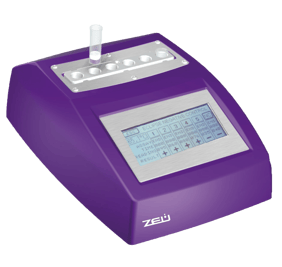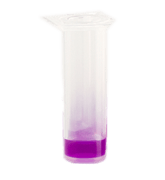 The presence of antibiotics in food has been a concern for years because of technological and analytical reasons but mostly due to their side-effects in human health. Besides the toxicity and allergenicity of some antibiotics, the main risk for humans comes from the misuse of antibiotics in animal husbandry that has been linked to antibiotic resistances. According to WHO antimicrobial resistances are one of the most serious threats to global public health over the world.
The presence of antibiotics in food has been a concern for years because of technological and analytical reasons but mostly due to their side-effects in human health. Besides the toxicity and allergenicity of some antibiotics, the main risk for humans comes from the misuse of antibiotics in animal husbandry that has been linked to antibiotic resistances. According to WHO antimicrobial resistances are one of the most serious threats to global public health over the world.
ZEULAB has developed a new procedure to analyze antibiotics in meat that combines an inhibitor tube test (Explorer 2.0) and the new device e-Reader. This device coupled to Explorer 2.0 incubates the assay at the selected temperature, determines the endpoint of the assay and interprets the results. Qualitative and numeric results are displayed in the screen and are also stored.
This system has been validated for meat samples according to the European Commission Decision 2002/657/EC and the results have been published in Food Additives & Contaminants: Part A, a peer-reviewed journal.
 Sensitivity towards 25 substances from several groups of antimicrobials was investigated in a first step. Detection capabilities for six substances representing the six major antimicrobial groups were also determined in bovine muscle. The detection capabilities for amoxicillin (10 µg l-1), cefalexin (200 µg l-1), doxycyclin (100 µg l-1), sulfamethazine (100 µg l-1), tylosin (100 µg l-1) and neomycin (200 µg l-1) were in all cases at or below the maximum residue limit (MRL). Specificity and applicability of the test were demonstrated with muscle samples from four animal species (bovine, porcine, ovine and poultry) and results were found to be very satisfactory. Ruggedness was
Sensitivity towards 25 substances from several groups of antimicrobials was investigated in a first step. Detection capabilities for six substances representing the six major antimicrobial groups were also determined in bovine muscle. The detection capabilities for amoxicillin (10 µg l-1), cefalexin (200 µg l-1), doxycyclin (100 µg l-1), sulfamethazine (100 µg l-1), tylosin (100 µg l-1) and neomycin (200 µg l-1) were in all cases at or below the maximum residue limit (MRL). Specificity and applicability of the test were demonstrated with muscle samples from four animal species (bovine, porcine, ovine and poultry) and results were found to be very satisfactory. Ruggedness was  evaluated on negative and spiked samples with sulfamethazine as a representative antimicrobial. Neither false-positives nor false-negatives were detected when varying the sample volume, the time of pre-incubation, the temperature of incubation and the batch of the test.
evaluated on negative and spiked samples with sulfamethazine as a representative antimicrobial. Neither false-positives nor false-negatives were detected when varying the sample volume, the time of pre-incubation, the temperature of incubation and the batch of the test.
These results proved that Explorer 2.0 coupled toe-Reader is a valuable tool for the screening of a broad range of antimicrobials in muscle. This new methodology simplifies the analysis and increases the accuracy of interpretation of the test results since the endpoint of the assay is automatically determined and results are interpreted objectively.
More information about the validation of the new procedure may be found in: http://www.tandfonline.com/doi/full/10.1080/19440049.2014.934303
More information about Explorer 2.0 and e-Reader may be found in our web site and in our Youtube chanel
ZEULAB has developed a new procedure to analyze antibiotics in meat that combines an inhibitor tube test (Explorer 2.0) and the new device e-Reader. This device coupled to Explorer 2.0 incubates de assay at the selected temperature, determines the endpoint of the assay and interprets the results. Qualitative and numeric results are displayed in the screen and are also stored.
This system has been validated for meat samples according to the European Commission Decision 2002/657/EC and the results have been published in Food Additives & Contaminants: Part A[Zeu1] , a peer-reviewed journal.
Sensitivity towards 25 substances from several groups of antimicrobials was investigated in a first step. Detection capabilities for six substances representing the six major antimicrobial groups were also determined in bovine muscle. The detection capabilities for amoxicillin (10 µg l-1), cefalexin (200 µg l-1), doxycyclin (100 µg l-1), sulfamethazine (100 µg l-1), tylosin (100 µg l-1) and neomycin (200 µg l-1) were in all cases at or below the maximum residue limit (MRL). Specificity and applicability of the test were demonstrated with muscle samples from four animal species (bovine, porcine, ovine and poultry) and results were found to be very satisfactory. Ruggedness was evaluated on negative and spiked samples with sulfamethazine as a representative antimicrobial. Neither false-positives nor false-negatives were detected when varying the sample volume, the time of pre-incubation, the temperature of incubation and the batch of the test.
These results proved that Explorer 2.0 coupled toe-Reader is a valuable tool for the screening of a broad range of antimicrobials in muscle. This new methodology simplifies the analysis and increases the accuracy of interpretation of the test results since the endpoint of the assay is automatically determined and results are interpreted objectively.
More information about the validation of the new procedure may be found in:
http://www.tandfonline.com/doi/full/10.1080/19440049.2014.934303
More information about Explorer 2.0 and e-Reader may be found in our web site (www.zeulab.com) and in our Youtube chanel https://www.youtube.com/watch?v=4PwmPkfID2w
